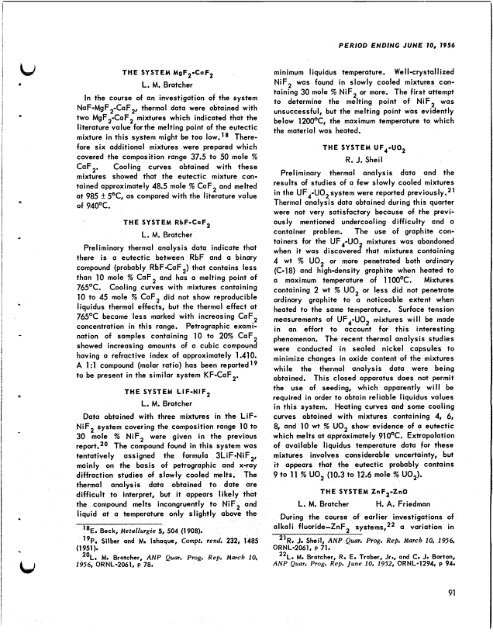ORNL-2106 - the Molten Salt Energy Technologies Web Site
ORNL-2106 - the Molten Salt Energy Technologies Web Site
ORNL-2106 - the Molten Salt Energy Technologies Web Site
Create successful ePaper yourself
Turn your PDF publications into a flip-book with our unique Google optimized e-Paper software.
THE SYSTEM MgF2-CaF2<br />
L. M. Bratcher<br />
In <strong>the</strong> course of an investigation of <strong>the</strong> system<br />
NaF-MgF2-CaF,, <strong>the</strong>rmal data were obtained with<br />
two MgF,-CaF, mixtures which indicated that <strong>the</strong><br />
literature value for<strong>the</strong> melting point of <strong>the</strong> eutectic<br />
mixture in this system might be too 10w.l~ There-<br />
fore six additional mixtures were prepared which<br />
covered <strong>the</strong> composition range 37.5 to 50 mole %<br />
CaF,. Cooling curves obtained with <strong>the</strong>se<br />
mixtures showed that <strong>the</strong> eutectic mixture con-<br />
tained approximately 48.5 mole % CaF, and melted<br />
at 985 f 5'C, as compared with <strong>the</strong> literature value<br />
of 940OC.<br />
THE SYSTEM RbF-CaF2<br />
L. M. Bratcher<br />
Preliminary <strong>the</strong>rmal analysis data indicate that<br />
<strong>the</strong>re is a eutectic between RbF and a binary<br />
compound (probably RbFCaF,) that contains less<br />
than 10 mole % CaF, and has a melting point of<br />
765OC. Cooling curves with mixtures containing<br />
10 to 45 mole % CaF, did not show reproducible<br />
liquidus <strong>the</strong>rmal effects, but <strong>the</strong> <strong>the</strong>rmal effect at<br />
765OC became less marked with increasing CaF,<br />
concentration in this range. Petrographic exami-<br />
nation of samples containing 10 to 20% CaF,<br />
showed increasing amounts of a cubic compound<br />
having a refractive index of approximately 1.410.<br />
A 1:l compound (molar ratio) has been reported19<br />
to be present in <strong>the</strong> similar system KF-CaF,.<br />
THE SYSTEM LIF-NIF,<br />
L. M. Bratcher<br />
Data obtained with three mixtures in <strong>the</strong> LiF-<br />
NiF, system covering <strong>the</strong> composition range 10 to<br />
30 mole % NiF, were given in <strong>the</strong> previous<br />
report.20 The compound found in this system was<br />
tentatively assigned <strong>the</strong> formula 3LiF*NiF,,<br />
mainly on <strong>the</strong> basis of petrographic and x-ray<br />
diffraction studies of slowly cooled melts. The<br />
<strong>the</strong>rmal analysis data obtained to date are<br />
difficult to interpret, but it appears likely that<br />
<strong>the</strong> compound melts incongruently to NiF, and<br />
liquid at a temperature only slightly above <strong>the</strong><br />
18E, Beck, Metallurgic 5, 504 (1 908).<br />
"Pa Silber and Ma Ishaque, Cornpt. rend. 232, 1485<br />
(1951).<br />
"La M. Bratcher, ANP Quar. Prog. Rep. March 10,<br />
1956, <strong>ORNL</strong>-2061, P 78.<br />
PERIOD ENDING JUNE 10. 1956<br />
minimum I iquidus temperature. We Il-crystal I ized<br />
NiF, was found in slowly cooled mixtures con-<br />
taining 30 mole % NiF, or more. The first attempt<br />
to determine <strong>the</strong> melting point of NiF, was<br />
unsuccessful, but <strong>the</strong> melting point was evidently<br />
below 1200°C, <strong>the</strong> maximum temperature to which<br />
<strong>the</strong> material was heated.<br />
THE SYSTEM UF4-U02<br />
R. J. Sheil<br />
Preliminary <strong>the</strong>rmal analysis data and <strong>the</strong><br />
results of studies of a few slowly cooled mixtures<br />
in <strong>the</strong> UF4-UO, system were reported previou~ly.~~<br />
Thermal analysis data obtained during this quarter<br />
were not very satisfactory because of <strong>the</strong> previ-<br />
ously mentioned undercooling difficulty and a<br />
container problem. The use of graphite con-<br />
tainers for <strong>the</strong> UF,-UO mixtures was abandoned<br />
when it was discovered that mixtures containing<br />
4 wt % UO, or more penetrated both ordinary<br />
(C-18) and high-density graphite when heated to<br />
a maximum temperature of llOO°C. Mixtures<br />
containing 2 wt % UO, or less did not penetrate<br />
ordinary graphite to a noticeable extent when<br />
heated to <strong>the</strong> same temperature. Surface tension<br />
measurements of UF,-UO, mixtures will be made<br />
in an effort to account for this interesting<br />
phenomenon. The recent <strong>the</strong>rmal analysis studies<br />
were conducted in sealed nickel capsules to<br />
minimize changes in oxide content of <strong>the</strong> mixtures<br />
while <strong>the</strong> <strong>the</strong>rmal analysis data were being<br />
obtained. This closed apparatus does not permit<br />
<strong>the</strong> use of seeding, which apparently will be<br />
required in order to obtain reliable liquidus values<br />
in this system. Heating curves and some cooling<br />
curves obtained with mixtures containing 4, 6,<br />
8, and 10 wt 95 UO, show evidence of a eutectic<br />
which melts at approximately 91OoC. Extrapolation<br />
of available liquidus temperature data for <strong>the</strong>se<br />
mixtures involves considerable uncertainty, but<br />
it appears that <strong>the</strong> eutectic probably contains<br />
9 to 11 % UO, (10.3 to 12.6 mole % UO,).<br />
THE SYSTEM ZnF,-ZnO<br />
L. M. Bratcher H. A. Friedman<br />
During <strong>the</strong> course of earlier investigations of<br />
alkali fluoride-ZnF, systems,22 a variation in<br />
21Ra J, Sheit, ANP Quar. Prog. Rep. March 10, 1956,<br />
<strong>ORNL</strong>-2061, P 71.<br />
M. Bratcher, R. E. Traber, Jr., and C. J. Barton,<br />
ANP Quar. Prog. Rep. June 10, 1952, <strong>ORNL</strong>-1294, p 94.<br />
91



![Review of Molten Salt Reactor Physics Calculations [Disc 2]](https://img.yumpu.com/21979492/1/190x247/review-of-molten-salt-reactor-physics-calculations-disc-2.jpg?quality=85)













